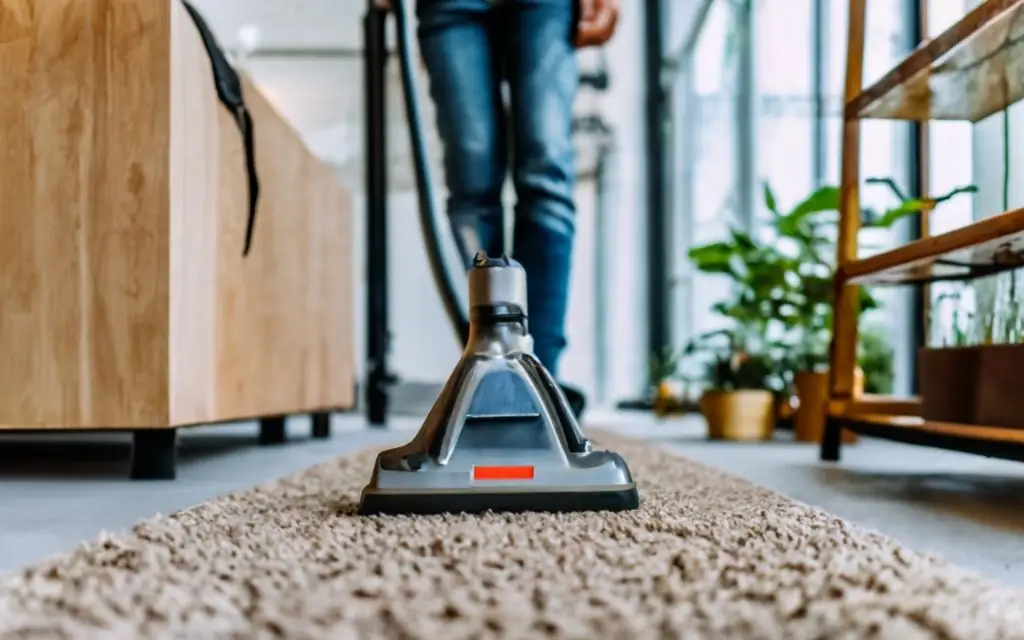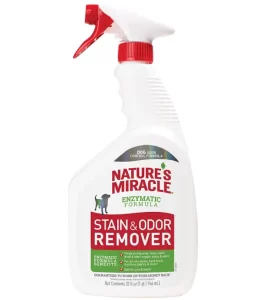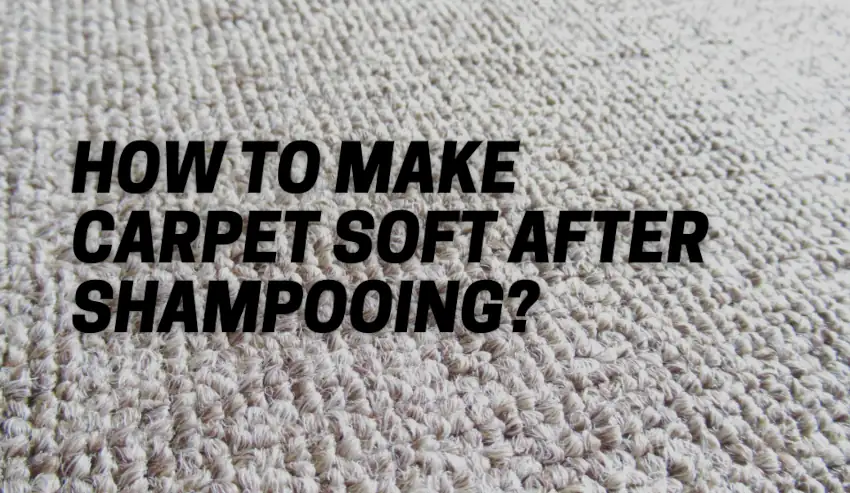Last updated on October 29th, 2023 at 02:26 am
If you’ve ever dealt with stubborn carpet stains or lingering odors, the idea of using an enzyme cleaner in a carpet shampooer may have crossed your mind. Enzyme cleaners have gained popularity for their remarkable ability to break down and eliminate organic stains and odors effectively. In this comprehensive guide, we’ll explore whether it’s safe and effective to put enzyme cleaner in your carpet shampooer, how to do it properly, and much more. Let’s dive in and demystify the process.
How to Use Enzyme Cleaner in a Carpet Shampooer
Using enzyme cleaner in your carpet shampooer can be a game-changer for tackling tough stains and odors. Here’s a step-by-step guide to help you do it right:
Step 1: Choose the Right Enzyme Cleaner Before you start, ensure you have a high-quality enzyme cleaner that’s compatible with your carpet shampooer. Not all enzyme cleaners are suitable for this purpose, so check the product label or manufacturer’s recommendations.
Step 2: Prepare Your Shampooer Thoroughly clean and prepare your carpet shampooer as per the manufacturer’s instructions. This typically involves filling the water tank, ensuring proper connections, and checking the condition of the machine.
Step 3: Mixing the Solution Follow the instructions on the enzyme cleaner’s label to mix the solution. The recommended dilution ratios may vary, so it’s crucial to get this step right. Using too little or too much cleaner can affect the cleaning process.
Step 4: Pre-Treat Stains If you have specific stains or problem areas, consider pre-treating them with a small amount of undiluted enzyme cleaner. Allow it to sit for a few minutes before starting the shampooing process.
Step 5: Shampoo the Carpet Operate the carpet shampooer as you typically would, ensuring that the enzyme cleaner solution is evenly distributed. Move the machine slowly to allow thorough cleaning and extraction of the solution.
Step 6: Allow Drying Time After shampooing, give your carpet ample time to dry. Avoid heavy foot traffic during this period to prevent re-soiling.
Dos and Don’ts:
- Do follow the manufacturer’s guidelines for both the carpet shampooer and the enzyme cleaner.
- Do a spot test in an inconspicuous area to ensure compatibility.
- Don’t mix enzyme cleaner with other cleaning products.
- Don’t over-saturate the carpet, as excess moisture can lead to mold and mildew growth.
What Are the Benefits of Using Enzyme Cleaner in Carpet Shampooers?
Using enzyme cleaners in carpet shampooers offers several benefits:
- Effective Stain and Odor Removal: Enzyme cleaners excel at breaking down and eliminating organic stains and odors, including those from pets, food, and spills.
- Eco-Friendly: Many enzyme cleaners are formulated to be environmentally friendly, using natural ingredients and producing fewer harmful residues.
- Safe for Pets and Children: Enzyme cleaners are generally safe for households with pets and children due to their non-toxic nature.
- Long-lasting Freshness: They leave your carpets smelling fresh for an extended period.
Are There Any Risks or Downsides to Using Enzyme Cleaners in a Shampooer?
While enzyme cleaners can be highly effective, there are some potential concerns to be aware of:
- Compatibility Issues: Not all carpet shampooers are compatible with enzyme cleaners. It’s essential to check your machine’s compatibility before use.
- Residue Buildup: If not properly rinsed and extracted, residue from the enzyme cleaner can accumulate in your carpet and lead to a sticky, soapy feel.
- Machine Maintenance: Using enzyme cleaners may require more frequent cleaning and maintenance of your carpet shampooer to prevent clogs or damage.
- Cost: Enzyme cleaners, particularly high-quality ones, can be more expensive than traditional carpet shampoos.
Best Enzyme Cleaners for Carpet Shampooers
When choosing an enzyme cleaner for your carpet shampooer, it’s crucial to opt for a reputable brand. Here are a few options to consider:
- Nature’s Miracle Advanced Stain and Odor Eliminator: This well-regarded product is known for its effectiveness in removing pet stains and odors.
- Bissell Professional Pet Urine Eliminator: Specifically designed for pet owners, it’s a trusted choice for tackling pet-related stains and odors.
- Rocco & Roxie Professional Strength Stain & Odor Eliminator: This enzyme cleaner is praised for its versatility in handling various organic stains and odors.
Best Enzyme Cleaner for Stains
These products have gained popularity for their reliability and effectiveness in carpet cleaning. However, always ensure that your chosen cleaner is suitable for your specific carpet and carpet shampooer.
How Often Should I Use Enzyme Cleaner in My Carpet Shampooer?
The frequency of using enzyme cleaner in your carpet shampooer depends on your specific needs and the level of soiling in your home. However, a general guideline is to use it as follows:
- Regular Cleaning: Use the enzyme cleaner in your carpet shampooer every 2-4 months for general maintenance and to keep your carpets fresh.
- Specific Stains or Odors: For specific issues like pet accidents or spills, use the enzyme cleaner as needed, following the instructions provided.
DIY Enzyme Cleaner Recipes for Carpet Cleaning
If you prefer a more hands-on approach, you can create your own enzyme cleaner for carpet cleaning. Here’s a simple recipe:
Ingredients:
- 2 cups of citrus peels (lemon, orange, or lime)
- 1 cup of brown sugar
- 1 tablespoon of yeast
- 4 cups of warm water
Instructions:
- Place the citrus peels in a large glass container or bottle.
- Add the brown sugar and yeast.
- Pour in the warm water.
- Stir the mixture, then cover the container with a breathable cloth or plastic wrap secured with a rubber band.
- Allow the mixture to ferment for about 2-3 weeks, stirring it every few days.
- After the fermentation period, strain the liquid and transfer it to a spray bottle. This liquid can be used as a DIY enzyme cleaner for your carpet.
Enzyme Cleaners vs. Traditional Carpet Shampoo: Pros and Cons
Enzyme cleaners and traditional carpet shampoos each have their advantages and disadvantages:
Enzyme Cleaners:
- Pros: Effective at breaking down organic stains and odors, eco-friendly, non-toxic, and leave long-lasting freshness.
- Cons: May not be compatible with all carpet shampooers, potential residue buildup, and can be more expensive.
Traditional Carpet Shampoo:
- Pros: Suitable for general cleaning, widely available, and cost-effective.
- Cons: May contain harsh chemicals, less effective on tough organic stains and odors.
The choice between the two depends on your specific needs, preferences, and the type of carpet you have.
Can Enzyme Cleaners Remove Pet Stains and Odors from Carpets?
Enzyme cleaners are highly effective at removing pet stains and odors from carpets. They break down the organic compounds responsible for the odors, making them a top choice for pet owners. The key is to choose an enzyme cleaner formulated for this purpose, follow the instructions carefully, and give it time to work its magic.
How Long Does Enzyme Cleaner Take to Work on Carpet?
The time it takes for an enzyme cleaner to work on a carpet can vary depending on several factors, including the type and severity of the stain or odor, the brand and formulation of the enzyme cleaner, and the specific instructions provided by the manufacturer. Here are some general guidelines:
- Immediate Action: For fresh spills or stains, enzyme cleaners can start breaking down the organic matter almost immediately upon contact. You’ll often see noticeable results within minutes as the enzymes work to break down the molecules responsible for the stain or odor.
- Deeper Stains and Odors: In the case of more stubborn or deeply embedded stains and odors, the enzyme cleaner may take longer to work. It’s not uncommon for it to continue its action for several hours or even overnight. The extended contact time allows the enzymes to penetrate deeper into the carpet fibers, ensuring thorough stain and odor removal.
- Drying Time: After applying the enzyme cleaner, it’s essential to allow the area to dry naturally. As the carpet dries, the enzymes continue their work. This process can take several hours or even longer, depending on factors like humidity, temperature, and the size of the treated area.
- Multiple Applications: In some cases, particularly with very old or severe stains, you may need to apply the enzyme cleaner multiple times to achieve the desired results. Follow the manufacturer’s instructions and be patient, as it may take a few applications to fully eliminate the stain or odor.
- Ventilation: Proper ventilation of the treated area can also impact how quickly the enzyme cleaner works. Good airflow can help the carpet dry faster, allowing the enzymes to be more effective.
It’s important to read the instructions on the specific enzyme cleaner you’re using, as different products may have varying recommendations for contact time and drying. In most cases, leaving the enzyme cleaner in place for an adequate amount of time, ensuring the area is adequately ventilated, and allowing it to dry naturally will yield the best results.
Tips for Maintaining a Clean Carpet with Enzyme Cleaners
To keep your carpets looking and smelling fresh, consider these tips:
- Regular Maintenance: Vacuum your carpets regularly to prevent dirt and debris from settling in.
- Prompt Stain Removal: Tackle stains as soon as they occur to prevent them from setting in.
- Proper Ventilation: Ensure good airflow in your home to help carpets dry faster after cleaning.
- Test in an Inconspicuous Area: Always perform a spot test before using any cleaner on your carpets.
- Professional Cleaning: Periodically, consider professional carpet cleaning to deep-clean your carpets thoroughly.
By following these tips and using enzyme cleaners, you can maintain a clean and odor-free carpet in your home.

Expert Data:
Let’s take a closer look at the expert data with a comparison table of enzyme cleaners vs. traditional carpet shampoos:
| Aspect | Enzyme Cleaners | Traditional Carpet Shampoo |
|---|---|---|
| Effectiveness on Organic Stains | Highly effective | Less effective |
| Eco-Friendly | Often eco-friendly | May contain harsh chemicals |
| Toxicity | Non-toxic | May contain toxic substances |
| Residue Buildup | Possible, if not properly rinsed and extracted | May leave residues |
| Freshness Duration | Long-lasting freshness | Shorter freshness duration |
| Compatibility with Shampooers | Compatibility varies, check product label | Generally compatible with most machines |
| Cost | May be more expensive | Generally cost-effective |
For more in-depth information and guidance on carpet cleaning and the use of enzyme cleaners, you can refer to authoritative sources such as The Spruce and The Carpet and Rug Institute.
In conclusion, using an enzyme cleaner in a carpet shampooer can be a powerful tool for maintaining clean and fresh carpets. When done correctly and with the right products, it can effectively remove stains and odors, leaving your carpets in top condition. Just be sure to follow the guidelines, choose the right cleaner, and consider the pros and cons to make an informed decision. Your carpets will thank you with a fresh and inviting ambiance.




